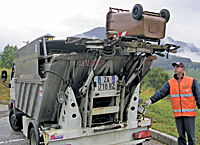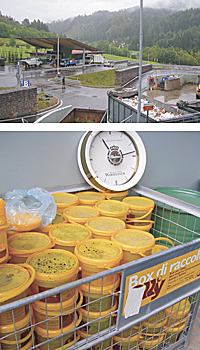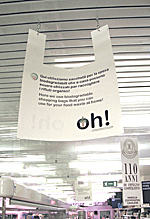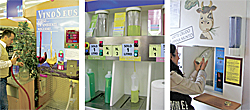 BioCycle October 2009, Vol. 50, No. 10, p. 39
BioCycle October 2009, Vol. 50, No. 10, p. 39
Award winning sustainability initiatives in Val di Fiemme help keep the popular valley pristine, while providing a worldwide role model for mountainous communities.
Rhodes Yepsen
VAL di Fiemme is a valley in northern Italy tucked in the Dolomite Mountains, a section of the Alps known for skiing in winter, and hiking in summer. In 2008 the municipality of 11 villages won an award for highest waste diversion in Italy, averaging over 82 percent diversion (with a peak of 85 percent). Its exemplary source separation scheme and initiatives such as plastic bag bans, special tourist collection boxes and tap water campaigns have made this community a leader in waste diversion and sustainability.
Six years ago, Val di Fiemme did not have any door-to-door curbside collection of waste, instead relying on larger street containers every few blocks. It continues to use the street containers for recyclables, due to space constraints for multiple household containers. “Although we would eventually like to have door-to-door collection of recyclables, the houses in Italy tend to be smaller, with not enough storage area for more than a few collection bins,” explains Giuseppe Fontanazzi, President of Fiemme Servizi, the public company that manages waste collection in the valley. “Our collection trucks are also much smaller, which allows them to fit down the narrow streets of our medieval towns, and makes for quick, efficient collection. No compaction is needed because the material is wet and dense.”
Organics are collected twice a week, and residual waste once a week. Residents are given a vented kitchen collector, a 25-liter (6.6-gallon) curbside organics bin just for food waste, and a 120-liter (31.7-gallon) bin for residual waste. Each household is also supplied with 200 compostable bags made from Mater-Bi, and 300 conventional trash bags. The trash bags are transparent green, to allow for checking the content, but also maintaining privacy. “There is an annual fixed fee of 80 Euros [117.50 USD] per four-person family, which covers street cleaning and supplies, and then a variable fee based on the volume of waste produced, which typically ends up being a total of about 120 Euros [176 USD],” says Fontanazzi. “We charge every time the residual waste container is tipped into the truck, whereas there is no additional fee for kitchen waste, which encourages residents to separate their organic wastes.” All containers are equipped with radio-frequency identification (RFID) tags, which records when bins are tipped into the collection truck. This is used to calculate the variable fee for residual waste, and to keep track of the amount of organics generated, as well as monitor participation.
A door-to-door educational campaign was conducted to explain the system, a process that took nearly a year. Clear communication was particularly important, as the residents went from having no curbside collection to being required to separate food waste and trash on a schedule. Idecom, an environmental communication and consulting firm, helped develop the educational materials and plan for this outreach.
“With public administration projects like this, it’s important to involve the citizens, to hear their concerns and respect their needs,” say Cristian Roverato of Idecom. “That way, when door-to-door campaigns start, the residents realize they are receiving a useful service, instead of feeling forced to respect new arbitrary rules. Our education strategies normally involve local TV, radio, local newspaper, public meetings, etc.”

Fiemme Servizi is responsible for 11 villages in the valley, with about 20,000 year-round residents. That population doubles with an influx of tourists in both the winter and summer seasons, creating a complicated situation for waste collection. Because it is unfeasible for short-term visitors to be responsible for curbside containers, Fiemme Servizi devised a system with cardboard boxes, compostable bags, and pink trash bags. “Besides increasing the labor for collection during vacation seasons, we also decided to provide tourists with an easy system that didn’t involve bins,” says Fontanazzi. “Tourists are given all of the supplies, typically through the property manager. A cardboard box serves as both kitchen collector and curbside bin, lined with a compostable bag, all of which can be composted. A transparent pink bag is used for trash without a bin. The color signals to us that it’s tourist waste, as anything in different colored bags on the street is considered litter.”
The small organics collection trucks drop off loads at a transfer station. Organics are currently trucked 200 km (124 miles) to a composting facility, but an anaerobic digestion plant is being constructed 50 km (31 miles) away to accept residential food waste. Trash is landfilled, but an incinerator is planned for the province in the city of Trento, which has raised concern in Val di Fiemme. “The waste-to-energy facility is designed with too large of a capacity, and will limit future composting and recycling efforts,” says Fontanazzi. “We have successfully lobbied to have the facility downsized, but the scheduled capacity is still predicated on an average of 60 percent waste diversion, not 80 percent, which we have proved is attainable.”

The transfer station has collection areas for recycling other residential materials, including florescent lights, electronics, white goods (refrigerators, washing machines, etc.), yard trimmings and vegetable oil. The vegetable oil is collected in yellow tubs and picked up by an Austrian company that uses it as fuel for a power plant.
Moving Towards Zero
Reaching 82 percent waste diversion is a laudable achievement, but capturing the remaining 15 to 20 percent can be tricky. After conducting waste audits, it was determined that baby diapers were the largest (by weight) organic material left in the residual waste stream. Although compostable diapers may be a commercially viable option in the future, the most immediate way to capture this material is through reusable diapers. Fiemme Servizi sends out a package of reusable cloth diapers, with compostable liners and wipes, to families with newborns as a welcoming gift to the community’s new resident. The local supermarket carries additional sizes of diapers. “The savings can be significant for families,” says Roberto Dallabona, Technical Staff at Fiemme Servizi. “Statistics show that parents typically pay 1,000 Euros [1,455 USD] in the first two years on disposable diapers, compared to a few hundred for cloth diapers. However, the reusable diapers have an additional financial incentive, because a heavy portion of the waste stream is diverted into the organics bin, which is free of charge.”

Fiemme Servizi is also addressing packaging. Several schemes are in place to reduce packaging, including a ban on plastic bags at supermarkets. “A letter was sent out explaining the campaign and the benefits of the compostable bag,” says Roverato of Idecom. “The letter included a sample compostable bag, and pointed out that best of all are reusable cloth bags. As part of the campaign, signs are hung in the supermarkets to remind shoppers that compostable bags are used at the store, and that they can be reused for the collection of the organic waste in the household.”
Many supermarkets in the valley are also switching to bulk dispensers for items to reduce unnecessary packaging. This includes foods like grains and cereals, as well as for wine and detergents. Some stores also have fresh milk dispensers, where an individual farm is assigned for each location. “The milk quality is tightly controlled at the farm, so there is no need for pasteurization, with fresh raw milk delivered to the store daily,” explains Dallabona. “The resident fills reusable glass milk bottles with affordable, high quality milk, knowing where it comes from. And the farmer receives a fair price, with less hassle.”

A new program is in place aiming to reduce the use of single-use plastic water bottles. Supermarket promotions were held for in-home carbonating machines, to add fizz to tap water. School children were given reusable metal water bottles with the saying, “Using tap water is better than from a bottle.” This initiative is important, considering that Val di Fiemme has excellent mountain spring water, and that Italy consumes more bottled water per capita than any other country – 184 liters/person in 2004, according to Beverage Marketing Corporation.
In addition, Val di Fiemme’s active timber and lumber industries create large quantities of wood waste. This woody biomass was previously a challenge to deal with, but is now being used as fuel at a community boiler. The facility provides municipal heat, much needed during the valley’s frigid winters. Hot water is pumped from the biomass boiler through highly insulated pipes that were recently installed under the towns’ medieval streets. The facility is currently being upgraded to be a combined heat and power (CHP) operation, and has solar panels on its roof to offset electrical costs.
Overall, Val di Fiemme’s sustainability initiatives continue to be successful. The remote valley’s circumstances are similar to other mountainous tourist regions, making it a worldwide role model for waste diversion.
October 20, 2009 | General










